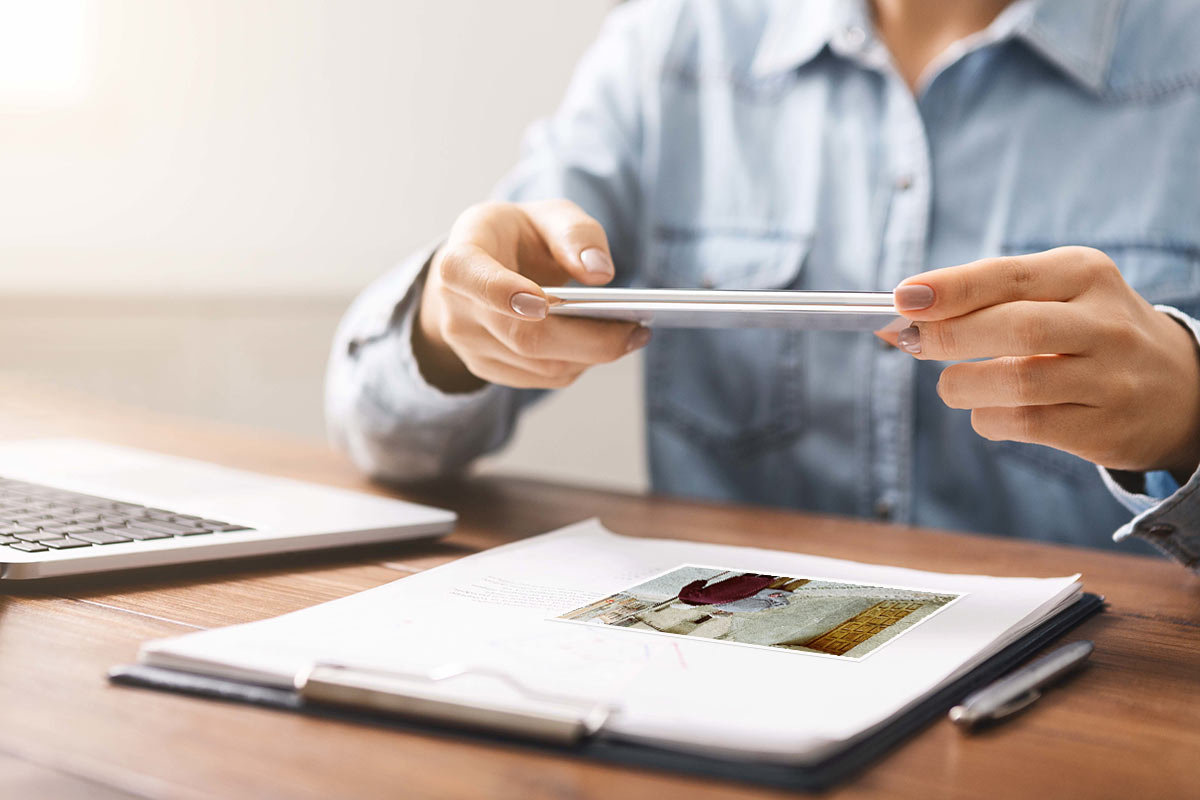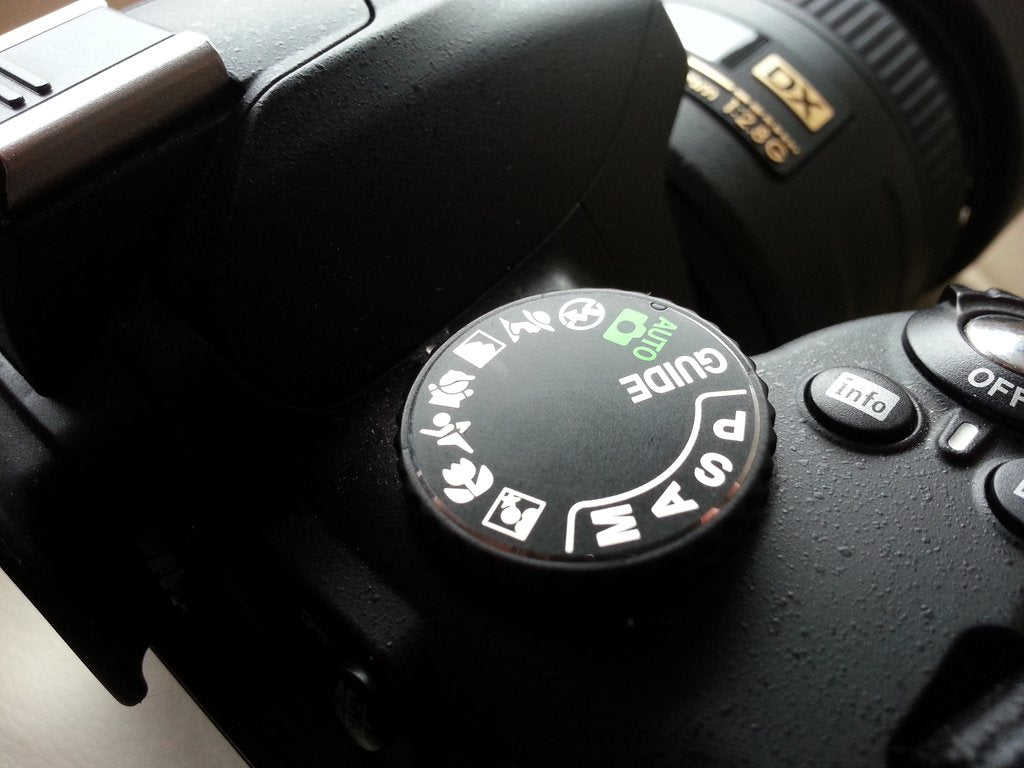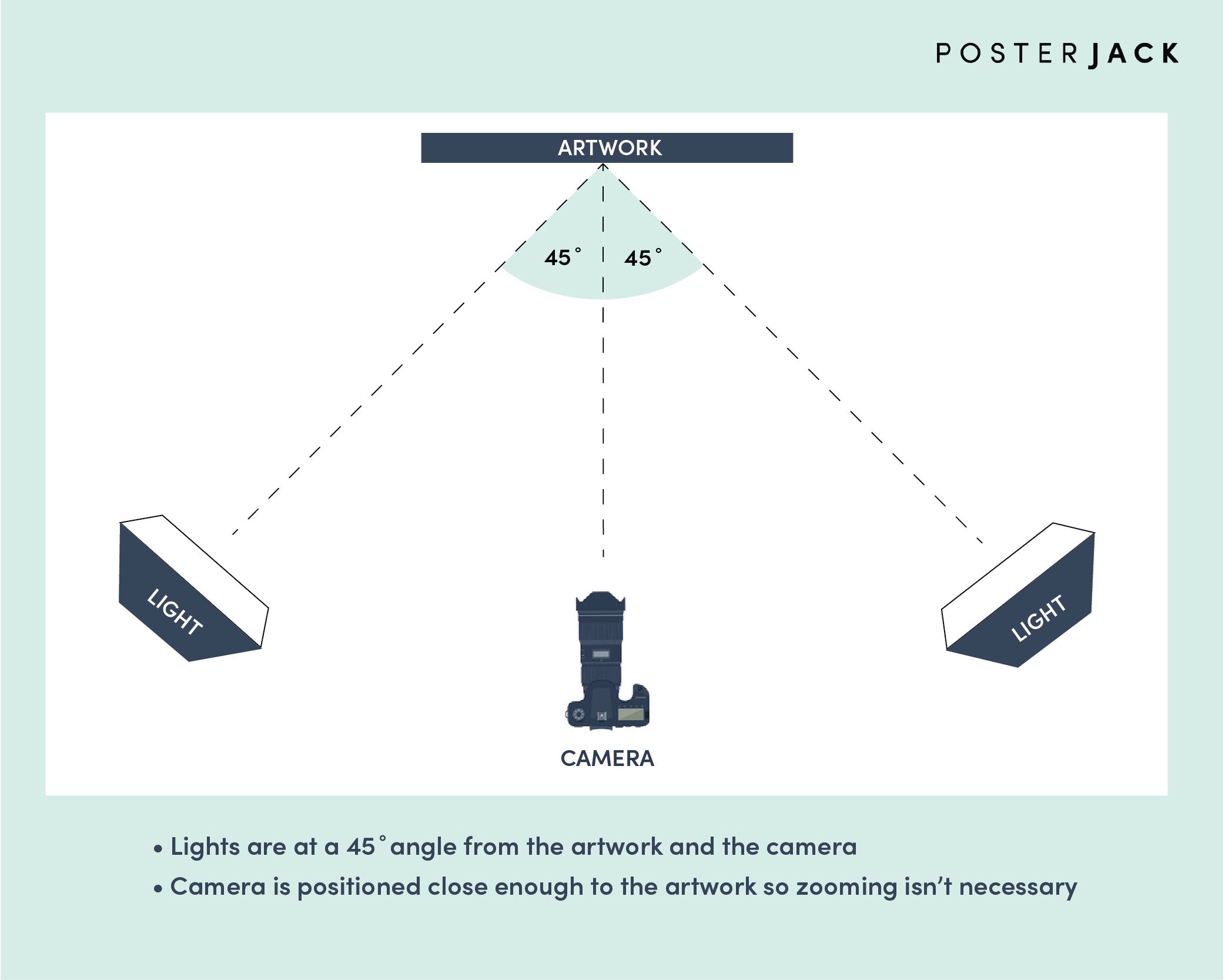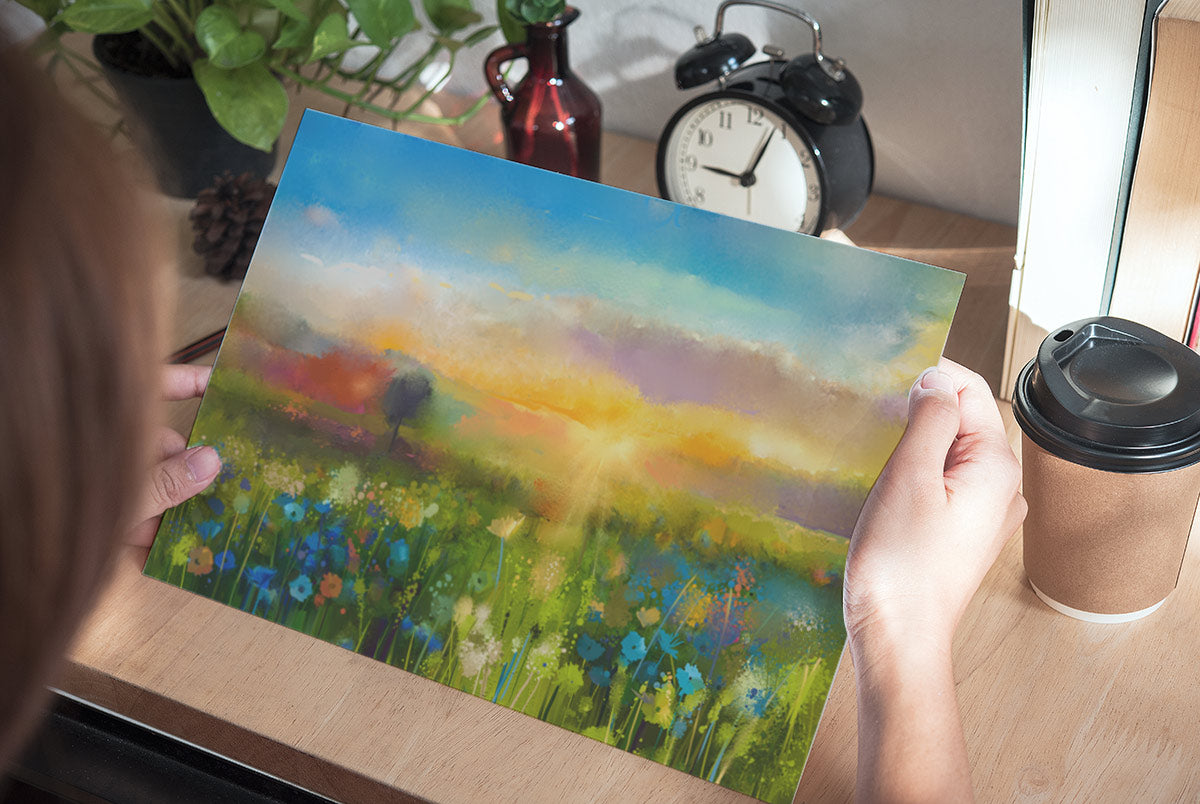How Do You Create Prints Of Original Paintings

Whether you're an artist looking to replicate your original paintings for resale or you lot're just looking for a mode to make a print of your artwork to gift to a friend or family member, yous don't demand access to fancy scanning equipment or expensive photography gear to get professional quality prints. In fact, by following a few tips, y'all tin can even get beautiful prints of your fine art using zilch more than your smartphone! This article will teach you how to photograph your artwork like a pro, and then your prints volition look absolutely incredible.
Is It Better to Scan or Photo Artwork?
If you accept access to a scanner and your artwork is suitable for scanning, this will probably be your best option, equally information technology'll exist easier to reproduce your fine art with greater accurateness and you won't need to worry about distortion, shadows, image blur, or other problems you may encounter when trying to photograph artwork. With that said, scanning your artwork might be difficult—or impossible—depending on the medium and size. Artwork that has a lot of texture and/or embellishments probable won't scan well considering y'all will lose a lot of the depth and dimension the original artwork had. If the size of your artwork is larger than the scanner, you will need to browse it in sections and then utilize editing software, similar Photoshop, to stitch it all together. In these cases, photographing your artwork for prints could exist a better option.
If yous do decide you lot'd like to scan your artwork to create prints, here are a few tips (originally shared in How to Enlarge Sometime Photos and Become Amazing Results):
Depending on the make and model of your scanner, the verbal steps you take to browse your artwork will vary, but it will probably just be a thing of placing the art face-down on the scanner's glass and pressing the scan button. Before scanning, however, in that location are a few settings you should bank check to ensure you're going to get the best scan for the purpose of creating prints of your artwork.
Color mode: Make sure you're scanning in color, not black and white or greyscale.
Resolution (DPI): For the purpose of scanning artwork for prints, the resolution should be ready to 300 dpi.
Data format/file type: JPEG
One time y'all've scanned your artwork using these settings, information technology's fix to be printed. All you need to exercise now is upload the file to our website and cull the product and size you would like your print to be created every bit and we'll take information technology from at that place!
Related: Preserving Your Kids Artwork With Posterjack
How to Photo Artwork for Prints
If using a scanner to reproduce your artwork isn't an option, y'all tin however become professional-looking results photographing your artwork for prints.
Choice one: Using a Smartphone to Take Photos of Your Art

Ideally, when photographing your artwork for prints, you should use a DSLR camera considering yous will have more options and command over the settings and the camera's sensor and lens will produce amend images. However, if all you have admission to is a smartphone, you tin even so capture photos of your artwork that will consequence in fantastic prints! Follow the lighting and composition tips below, but as you would with a DSLR camera, simply if you're using a smartphone, don't forget to clean the lens. Considering our phones are constantly in our hands, being put in and out of our pockets, possibly even being handled by the sticky little fingers of our tiny humans, the lens on the phone easily picks upwards finger prints, oils, and grime. Take a second to wipe it off with a textile before photographing your artwork to ensure you become the sharpest, clearest image possible.
Option ii: Using a DSLR Photographic camera to Take Photos of Your Art

As we simply mentioned, capturing photos of your artwork using a DSLR camera is a better option than using a smartphone camera, as information technology'll produce sharper images and yous'll have more than command over your settings.
Lens: A 50mm prime lens is ideal for photographing artwork. If you take to employ a lens with a shorter focal length, endeavour to avoid annihilation under 24mm. Shooting with a broad angle lens can cause barrel distortion, which ways direct lines in your artwork will announced to bend in the photo.
Aperture: The sharpest images are produced with the aperture set to f/five.half dozen to f/xi. Using a wide discontinuity creates a shallow depth of field, which isn't necessary when photographing artwork, and lens diffraction will decrease the sharpness of your image if you shoot at anything much greater than f/11.
Related: Agreement Depth of Field
ISO: ISO settings command how sensitive your camera's sensor is to light. A high ISO allows more light in, which is great when shooting in depression-light atmospheric condition, merely the payoff is image noise and grain in the photo - something you don't want when photographing artwork to create prints! For the sharpest image possible, set your camera's ISO to 100.
White Residual: When taking photos of your artwork to create prints, you want the prototype'due south colours to be as close to the original art every bit possible. Adjusting your camera's white balance settings volition significantly help with this considering it's letting your camera know what low-cal sources are beingness used and volition accommodate the colour temperatures accordingly. If you're not sure which setting to choose, don't exist afraid to experiment and try a few! Yous tin can also conform the white balance using photo editing software afterward.
Setting Up Your Lighting in 5 Steps
Specialized equipment, like softboxes and polarizing filters, can make it easier to photo your artwork, but you can get by without these accessories and still get outstanding results. In fact, you can successfully take pictures of your artwork without studio lights or a tripod, only we'll become to that in a moment.
For an indoor photoshoot, you will demand:
- A tripod
- Two brilliant, identical lights
- A wall to hang your artwork on
- Measuring tape
Optional, but helpful:
- 2 white sheets (or something like to diffuse each light)
- Photographic camera remote shutter release
- White piece of paper
- Level
Step 1: If your artwork is in a frame, you'll need to remove it in lodge to avoid glare and reflections. Likewise, if you're planning to add varnish to your original artwork, photograph it before doing and then if possible.
Stride ii: Hang your artwork flat on the wall. Assuming your art isn't also heavy, a thumbtack should do the trick, every bit it won't be upwardly there for long. If you lot have a level, check to brand sure information technology's straight. If you program to edit your image later on to adjust its colours and white balance, consider either hanging your artwork confronting a pure white wall or merely hang a white piece of paper directly beside yours art (it'll be cropped out afterwards). This will allow you to utilize the eyedropper tool in your editing software to adjust the white residual later.
Step iii: Position your camera on a tripod at a distance from the artwork which allows yous to fill the camera's frame without needing to optically or digitally zoom. When yous compose the shot, although you desire to fill your frame, don't do then too tightly - if you include an inch or so of the groundwork behind your artwork, information technology volition make editing your photograph a fiddling easier later on since you'll be able to rotate/straighten the shot without any of the artwork being cropped out in the procedure.
Stride 4: When positioning your camera, information technology's very of import that the camera lens is parallel to the artwork and the lens of the camera and middle of the artwork is at the same height. Use a measuring tape to measure from the ground to the centre of the artwork and then adjust the top of your photographic camera to be the same. If the superlative isn't the same or if the camera is angled from the artwork, your photograph of your artwork will be distorted.

Stride five: With your artwork and camera fix, you can now position your lights. You want them directed at your artwork and at a 45º angle on each side of the photographic camera. Although your lights need to be brilliant, you'll get better results if yous can diffuse the lighting. You can do so simply by hanging a white canvas in front of each light. If yous don't have white sheets, you tin can experiment with other semi-transparent white objects you can find around the house, like t-shirts, parchment or wax paper, white garbage bags, or even printer newspaper.

Important: The lights tin go hot and the material you use can be flammable, and then be careful you don't fix your diffusers where they tin can catch on fire!
Tips for Photographing the Art
- If you're shooting indoors with your camera's ISO settings at 100, your camera needs more external light in order to capture proficient photos. Apply the brightest lights possible (with a diffuser). Allowing more light into your camera'southward sensor will produce a higher quality, sharper image.
- For the sharpest images possible, it'south important to go along your camera as steady as possible. If you don't have a tripod, position your camera on a table. Y'all can stack books on peak of the table as well to adapt your camera to the correct summit.
- Pressing the shutter button on your camera can even cause you to lose sharpness in your photo. Utilise a remote shutter release if you lot take i or set your camera'due south timer so yous don't need to manually hit the shutter push button.
- Don't use your camera's flash.
- If y'all don't have lights to use like in the set-upwardly in a higher place, y'all can photograph your artwork successfully outdoors using natural light! A cloudy solar day is the all-time, since the clouds naturally diffuse the light. Failing that, when shooting outdoors, notice a shady area at the side of your business firm or other large structure. You want to avoid the harsh, direct sunlight, equally it will cast shadows on your artwork.
Tips for Editing Your Artwork Photos Earlier Printing
When editing the photos of your artwork, a few mail-processing steps you tin can consider are:
Straightening: If needed, rotate your image so that it'south completely direct. This is why we recommended that yous include an inch or so of the groundwork behind your artwork when composing your shot. Digitally rotating the epitome without that extra space would cut off part of the artwork.
Cropping: One time you lot've adjusted your photo and so information technology's directly, you tin go ahead and crop out the background. You don't want to come across anything in the image except your masterpiece when creating professional person-quality prints of your original artwork!
Colour Correction: You can accommodate the white balance, contrast, brightness, and sharpness of your prototype, but don't become overboard! You want your image to look equally close to the original artwork equally possible.
Making Prints of Your Artwork
Now that you've created digital copies of your original artwork, it's time for the fun part: making prints! We offer a large variety of photo art products, but hither are a few worth because that are pop with artists.

Posterjack Fine Fine art Prints are made with 308 GSM 100% cotton Hahnemuehle Photo Rag, i of the world'southward all-time fine art papers. Using the giclee (inkjet) method, nosotros use not-toxic and eco-friendly HP Vivera inks and proprietary printing software, so your prints will be vibrant and beautiful. They're also rated to be fade-resistant for 200+ years! They're available in over 40 unlike sizes, and yous can even have them custom framed in ane of six different frame styles. If you lot're considering printing your artwork on something like canvas, metal, or acrylic but want to commencement impress a sample to ensure you're happy with the photo of your artwork, Art Prints are great for this purpose too.
A Posterjack Acrylic Impress is a custom piece of photo fine art made with premium-quality materials. From our Toronto workshop, nosotros impress your photo directly onto ane/4-inch thick, optically clear acrylic drinking glass using the giclée method. Once your photo is printed on the acrylic, our Photograph Art Experts mountain it to a white protective backing sail and then finish it off by polishing the edges to a crystal-clear sheen. Information technology's our top product, and for good reason! Check out What Is An Acrylic Print to larn more than about them.

Although nosotros offering three different types of Metallic Prints, each with their own unique characteristics, our Matte White Metal Prints are a popular option for press artwork because of their satin-matte cease. They're perfect for displaying in virtually whatsoever situation, including rooms with bright lights or overhead lighting. They're rated to be fade-resistant for 200+ years, and are printed using advanced SwissQ impress equipment for superior prototype quality. Your artwork volition exist printed on a 3mm white-coated aluminum panel and you can cull one of four hanging options—Float Mount, Standoff Kit, Modern Bladder Frame, or Standard Frame—no hanging/framing options are also available.
Related: Everything Y'all Need to Know Almost Metallic Prints
Posterjack Canvas Prints are are expertly manus-stretched and made right hither in Canada, from our Toronto location. Our goal is to provide Canadians the best canvass prints available, which ways nosotros simply use premium materials similar thick poly-cotton wool canvas that won't sag, and kiln-dried Canadian basswood frames that won't warp. In addition to ensuring the materials we use are 2nd to none, we put just as much effort into making certain your artwork looks its best! Nosotros print photos using our proprietary PJ-Print™ software and world-class printers using green certified HP inks that will not fade for 200 years. The quality and care we put into creating our Canvas Prints means you become a beautiful piece of custom fine art you can proudly display on your wall and years down the road, information technology will look just as vibrant as the mean solar day you lot got it.

If y'all can't make up one's mind what you'd like to print your artwork on, you can order a Sample Box, which includes a variety of materials nosotros print on, plus a $10 gift certificate to use on your side by side order.

Source: https://posterjack.ca/blogs/inspiration/how-to-make-prints-from-original-artwork
Posted by: tripletttherhavery.blogspot.com



0 Response to "How Do You Create Prints Of Original Paintings"
Post a Comment